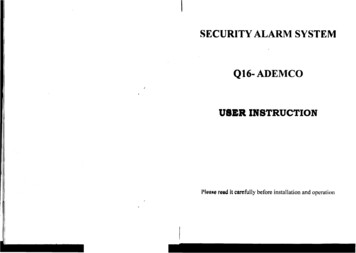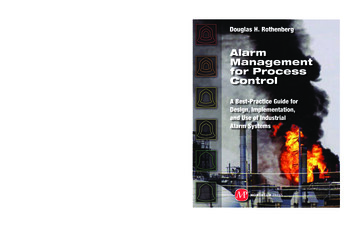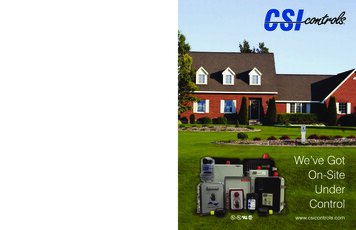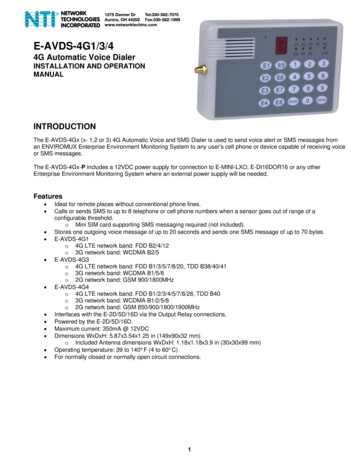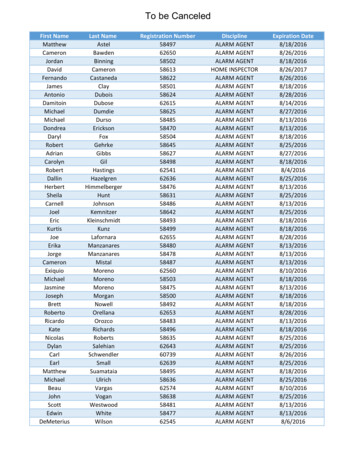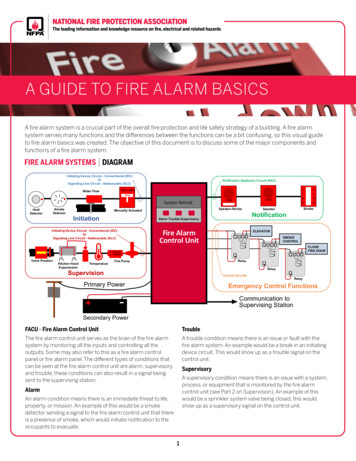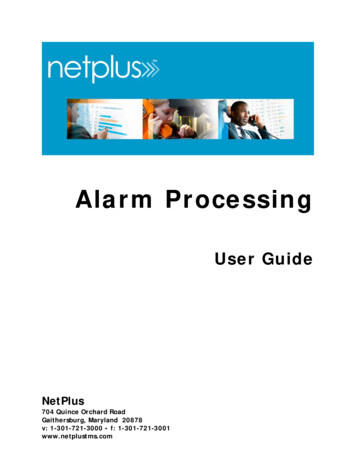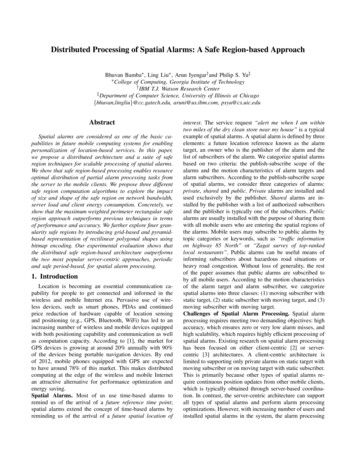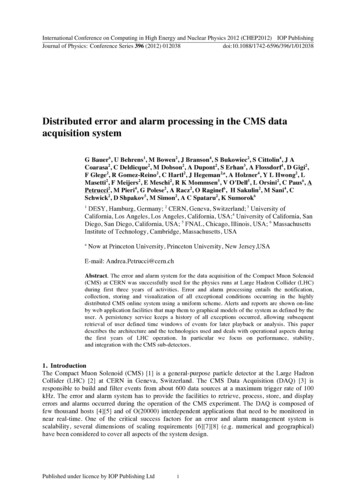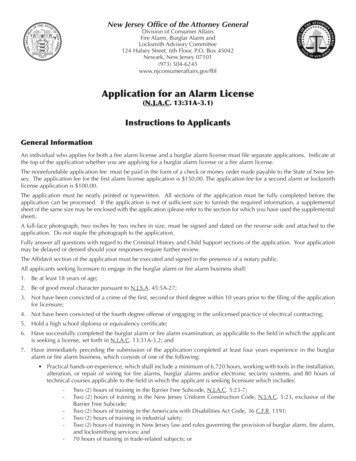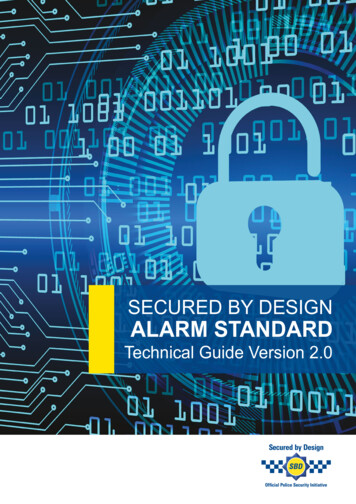
Transcription
SECURED BY DESIGNALARM STANDARDTechnical Guide Version 2.0
ContentsCompany Requirements3Technical Requirements (Residential)4Technical Requirements (Commercial)5Annexe A – Training Requirements7Annexe B – Record of differences from original standard to V2.07NPCC Security Systems Group Contacts7IntroductionSecured by Design (SBD) is part of Police Crime Prevention Initiatives (Police CPI), a police ownedorganisation that delivers a wide range of crime prevention and demand reduction initiatives acrossthe UK, and brings organisations together to create safer communities.Police CPI provide the Secretariat to the National Police Chiefs’ Council (NPCC) SecuritySystems Group to monitor police strategies and technical developments and advise on policerequirements. Police CPI also provide support to police forces and the private security industry onthe administration of police response to security systems, including intruder alarms.Police CPI work with the national alarm inspectorate bodies and trade organisations for thesecurity industry – the National Security Inspectorate (NSI), the Security Systems and AlarmsInspection Board (SSAIB), the Fire and Security Association (FSA) and the British SecurityIndustry Association (BSIA) – to develop a partnership approach with the private security industry,specifically to improve the performance of security systems and increase the preventative impactand detection rate emanating from such systems.Due to Police CPI’s technical intervention and the unified approach by police forces, there has beena decrease of over 1.1million false calls to the police due to faulty equipment or user error. When setagainst a backdrop of an increase of 796,078 registered alarms in 1995 to 1,493,706 in 2020, thisrepresents a significant reduction in demand on police time and resources.Following increasing industry interest, Police CPI has created a new SBD Alarm Standard for alarminstallation companies that will provide a high quality alarm system and further reduce false calls.The new standard is not a replacement for the NPCC Security Systems Policy or an alternative forcertification by a UKAS accredited certification body – currently delivered by the NSI and SSAIB – butincorporates the existing criteria whilst building on police and industry knowledge and expertise toproduce the new enhanced SBD Alarm Standard.The SBD Alarm Standard has been introduced to further reduce false calls and to provide an alarmsystem of an enhanced quality.Our team of Development Officers will help guide you through the process of gaining membershipand explore with you the advantages of becoming a SBD police recognised alarm system installer.For more information visit: https://www.policesecuritysystems.comor contact your nearest SBD Development ct-us2
11.1Company requirements for SBD Alarm SystemsTrading1.1.1 Companies will be required to have been compliant with their home police force for aminimum period of 2 years.1.1.2 Evidence that an SBD Alarm System has been installed in accordance with this standardmust be provided by either the NSI or SSAIB following their inspection. This confirmationmust be supplied to SBD before membership can be secured. At least one inspection ofan installed SBD Alarm System is to be performed each year. This is to ensure that furtherinstallations and SBD Alarm Systems, continue to meet the requirements of the SBD AlarmStandard. Again, SBD are to be notified of such by the NSI or SSAIB.1.2Sales1.2.1 In order to counter the harassment, intimidation, distress and threatening behaviour thatsometimes accompanies some forms of unlawful Direct Marketing activity, sales of SBDAlarm Systems shall only be via marketing routes that comply with the following:a. All electronic and telephone communication, by whatever means, with potential andexisting customers shall be in accordance with the Privacy and Communications (ECDirective) Regulation 2003 (PECR), see the Information Commissioners Office DirectMarketing Guidance document at: ance.pdfb. All face to face doorstep sales staff (directly or indirectly employed) shall comply with the‘Consumer Contracts (Information and Additional Charges) Regulations 2013’.c. All door to door sales shall be compliant with the law, further guidance regarding door todoor sales and the legal requirements and implications can be found at: Training1.3.1 The design, installation, commissioning and maintenance of the SBD Alarm System, shallbe approved by individual(s) holding industry recognised qualifications and competencies,e.g. NVQ Level 2; BTEC Level 3; Certified Technical Security Professional (CTSP) or, Fire,Emergency and Security Systems (FESS) Level 3 Apprenticeship Standard1.3.2 All end users shall be fully trained in the use of the SBD Alarm System in accordance withAnnex A.3
1.4Procedural1.4.1 Remote restores, sometimes known as remote resets, are not allowed after a policed falsealarm activation. Resets for policed false alarm activations are to be completed on site by anengineer only.1.4.2 Following commissioning and handover, all SBD Alarm Systems will be subject to a 14 daysoak test period before a police response is requested by the Alarm Receiving Centre (ARC).1.4.3 Engineers must place the system on test with the ARC when they arrive on site and removefrom test when they leave. No alarm activations shall be sent to the police during that periodunless accompanied by an audio-visual confirmation or a duress code.1.4.4 The licence for an individual SBD Alarm System may be removed if two or more policed falsealarm activations are recorded in a rolling 12 month period, if caused by: Engineers not putting the SBD Alarm System on test Errors during the installation and commissioning process1.4.5 The performance of SBD Alarm Systems will be monitored by the police for compliance andreliability.22.1Technical requirements for a SBD Alarm System (Residential)Standards and Grades2.1.1 A ll SBD Alarm Systems to be compliant with ‘PD 6662 Scheme for the application of EuropeanStandards for intruder and hold up alarms’, and only certificated equipment is to be used.2.1.2 The minimum requirement is a Grade 2 alarm system with the addition of anti-maskingproperties.2.2Signalling2.2.1 SBD Alarm Systems will have dual path signalling to Dual Path 2 standard as a minimum.2.3Hold-up Alarms2.3.1 Exposed cables for hold-up alarm buttons should be physically protected by ducting,conduit or trunking.2.3.2 Where there is no hold-up facility on the premises, hold-up signals on the Alarm TransmissionSystem (ATS) should be prevented.2.4Power2.4.1 Mains failure must be adequately managed by providing a stand-by power source to allowfor a minimum 12hrs supply.2.4.2 Mains failure must also be signalled to the ARC and keyholders notified immediately.2.5Confirmation Hold-Up Alarm2.5.1 Confirmation of such a signal is required and is to be based on a risk assessment of thepremises and occupants, and may be:i) Video4ii) Audioiii) Sequential
2.6Confirmation of Intruder Alarms2.6.1 Two methods of confirmation are required based on a risk assessment of the premises andoccupants, i.e.i) Sequential and video2.7ii) Sequential and audioiii) Audio and videoOpening Contacts2.7.1 All perimeter doors are to have a contact fitted.2.8Setting and Unsetting2.8.1 Setting and unsetting with a remote device controlled from a distance by the use of radio orelectronic signals (e.g. mobile phone) is not permitted.33.1Technical requirements for a SBD Alarm System (Commercial)Standards and Grades3.1.1 All SBD Alarm Systems to be compliant with ‘PD 6662 Scheme for the application ofEuropean Standards for intruder and hold up alarms’, and only certificated equipment is tobe used.3.1.2 The minimum requirement is a Grade 2 alarm system but with the addition of anti-maskingproperties.3.1.3 BS 8243 Installation & configuration of intruder and hold up alarms designed to generateconfirmed alarm systems, unsetting options 6.4.2 & 6.4.3 are permitted only.BS 8243 6.4.2 – Prevention of entry to the supervised premises before the intruder alarmsystem is unset.BS 8243 6.4.3 – Prevention of entry to the supervised premises before all means of intruderalarm confirmation are disabled.5
3.2Signalling3.2.1 Systems should have dual path signalling to Dual Path 2 as a minimum.3.3Hold-Up Alarms3.3.1 Exposed cables for hold-up alarm buttons should be physically protected by ducting, conduitor trunking.3.3.2 Where there is no hold-up facility on the premises, hold-up signals on the AutomaticTransmission System (ATS) should be prevented.3.3.3 Hold-up alarms from any part of the system that is set, should not result in a police response.3.4Power3.4.1 Mains failure must be adequately managed by providing a stand-by power source to allowfor a minimum 12hrs supply.3.4.2 Mains failure must also be signalled to the ARC and keyholders notified immediately.3.5Confirmation of Hold-up Alarm3.5.1 Confirmation is required and is to be based on a risk assessment of the premises andoccupants and may be:i) Video3.6ii) Audioiii) SequentialConfirmation of Intruder Alarms3.6.1 Two methods of confirmation are required based on a risk assessmentof the premises and occupants, i.e:i) Sequential and video3.7ii) Sequential and audioiii) Audio and videoSub-systems3.7.1 Sub-systems must have adequate safeguards to ensure staff cannot enter protected areaswhile alarmed, e.g. electronic door locks linked to the system and turning it off prior tostaff entering.3.8Setting and Unsetting3.8.1 Setting and unsetting with a remote device controlled from a distance by the use of radioor electronic signals (e.g. mobile phone) is not permitted.6
Annex AUser Training Requirements1. Setting and unsetting of the alarm system.2. Alarm abort procedure, including passwords.3. Checking all perimeter doors and windows are closed and secure.4. Correct use of the hold-up alarm system in accordance with NPCC Policy.5. Keeping a record of alarms and engineer visits.6. How to conduct a regular user walk test.Annex BRecord of differences between the original SBD Alarm Standard and Version 2.0Introduction: New statistics and rewording.1.1.2 Evidence of competence to install SBD Alarm Systems.1.2.1 Clarified requirements and guidance offered regarding direct marketing activity.1.3.1 Addition of ‘BTEC Level 3; Certified Technical Security Professional (CTSP)’ as aqualification option, and the accompanying note.1.4.1 New reference to policed false alarm calls.1.4.4 New reference to the removal of an individual SBD Alarm System under certain circumstances.1.4.5 Removal of reference to a 50% false call rate.2.4.1 In the event of power failure a 12 hour battery supply is now required and not 24 hour.3.4.1 In the event of power failure a 12 hour battery supply is now required and not 24 hour.NPCC Security Systems Group ContactsKen MeanwellDavid MairStaff OfficerTechnical RepresentativeNPCC Security Systems GroupNPCC Security Systems GroupT: 07770 237173T: 020 7230 0749E: ken.meanwell@police-cpi.co.ukE: david.j.mair@met.pnn.police.ukFor further information regarding Secured by Design membership, please visit:www.securedbydesign.com (Home page/Member Companies/How to Join)7
Police Crime Prevention Initiatives1st Floor10 Victoria StreetLondonSW1H 0NNT: 0203 8623 999E: enquiries@police-cpi.co.ukW: policecpi.comSBDTG0122
2.1.2 The minimum requirement is a Grade 2 alarm system with the addition of anti-masking properties. 2.2 Signalling 2.2.1 SBD Alarm Systems will have dual path signalling to Dual Path 2 standard as a minimum. 2.3 Hold-up Alarms 2.3.1 Exposed cables for hold-up alarm buttons should be physically protected by ducting, conduit or trunking.
